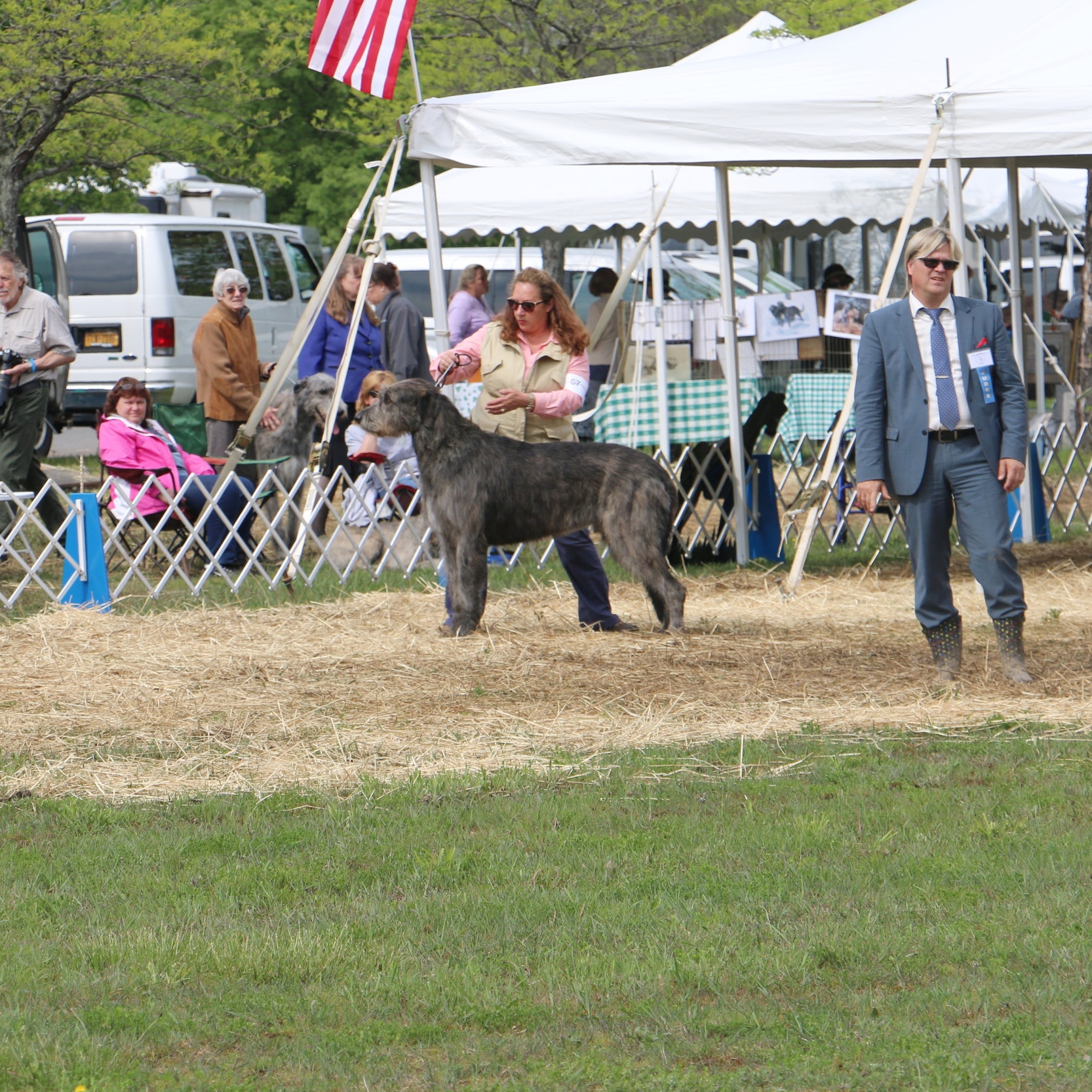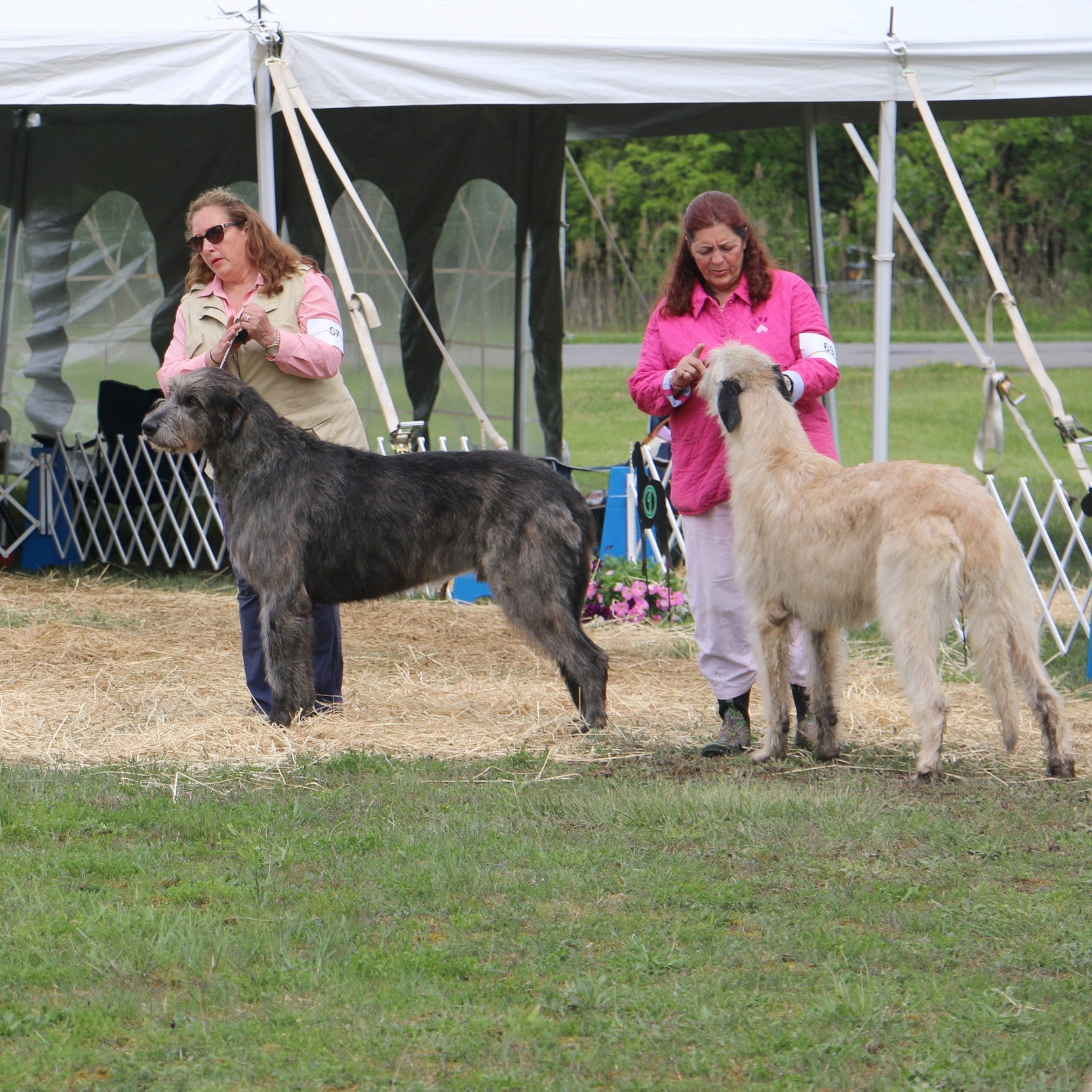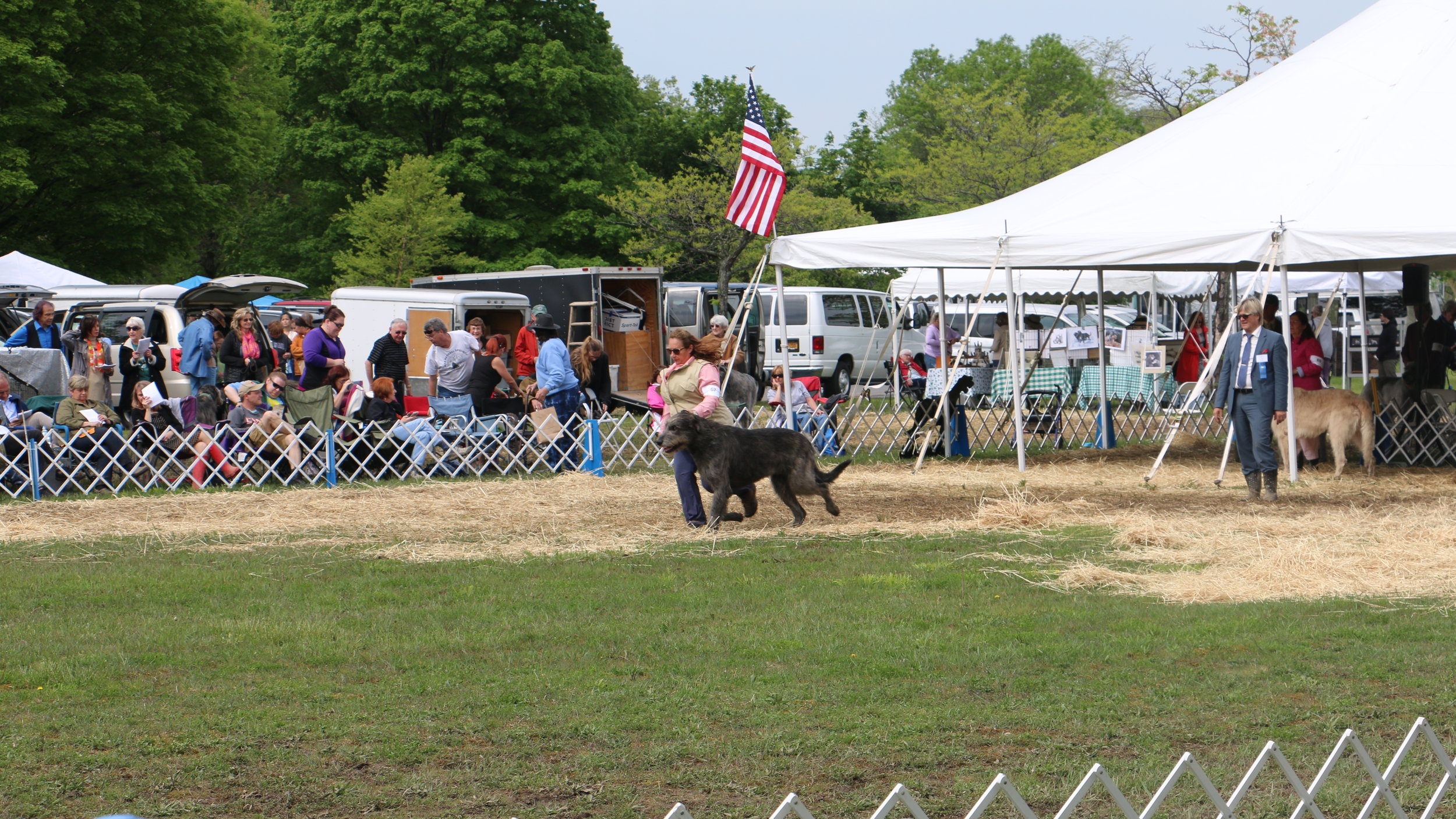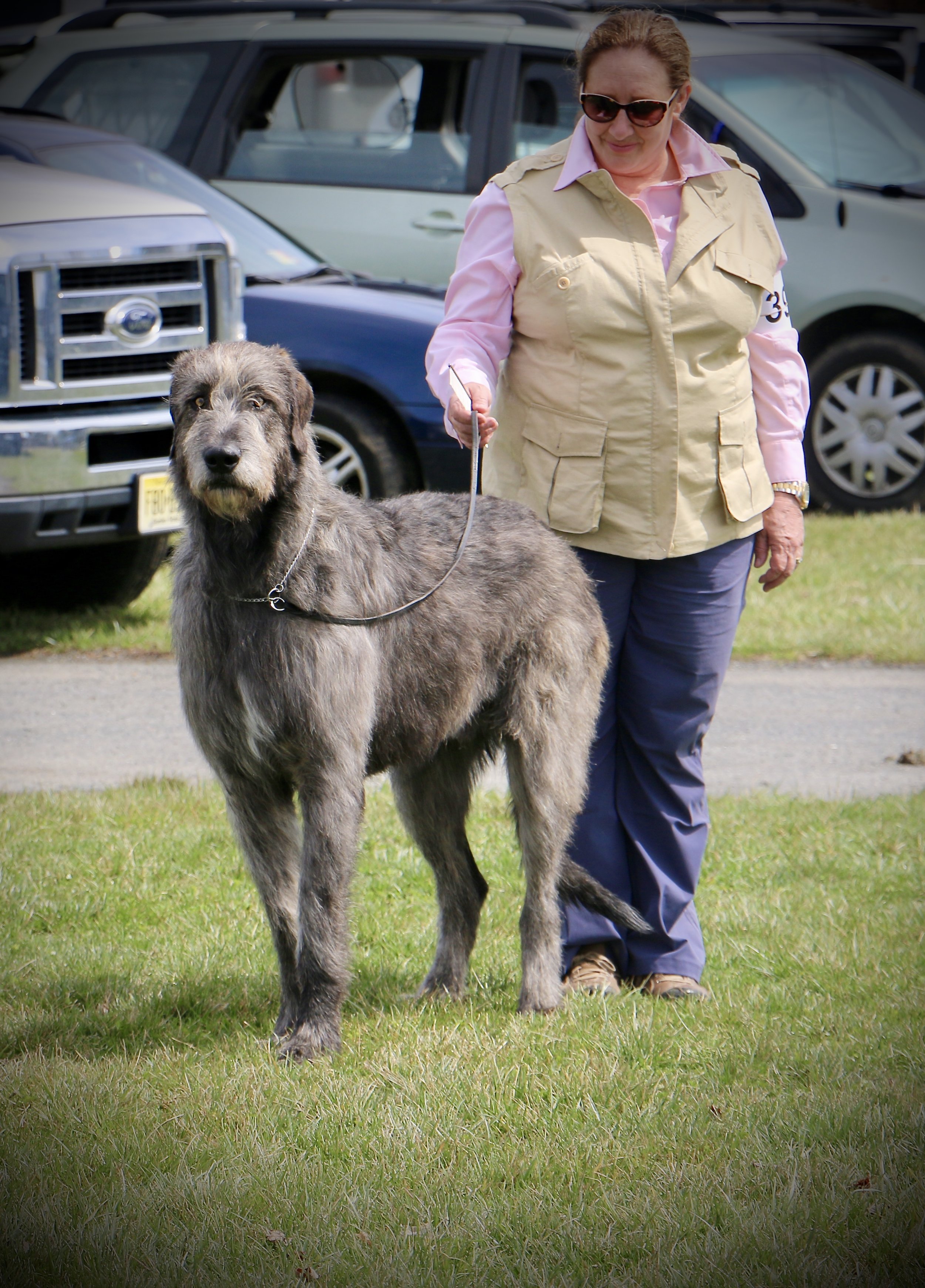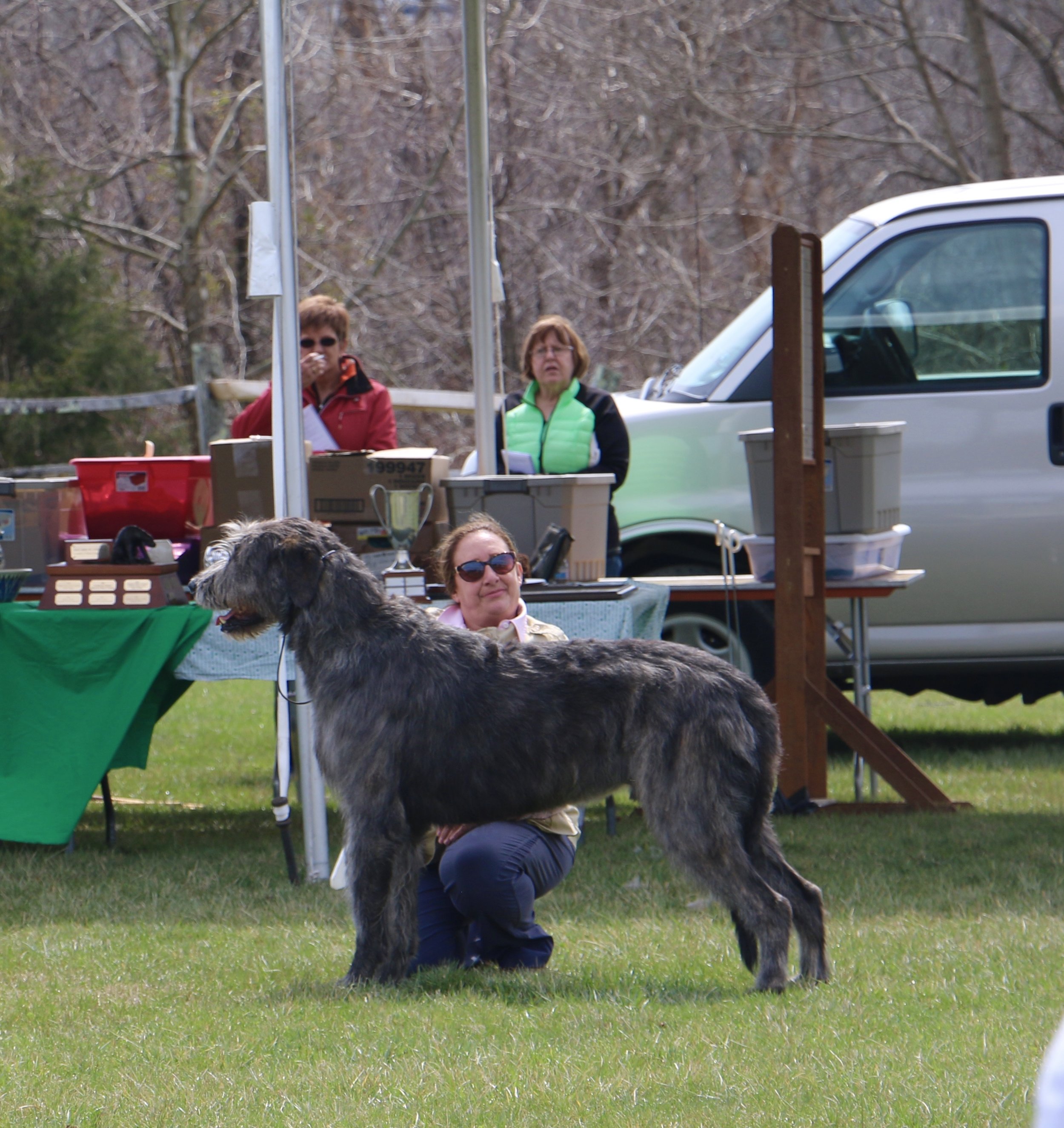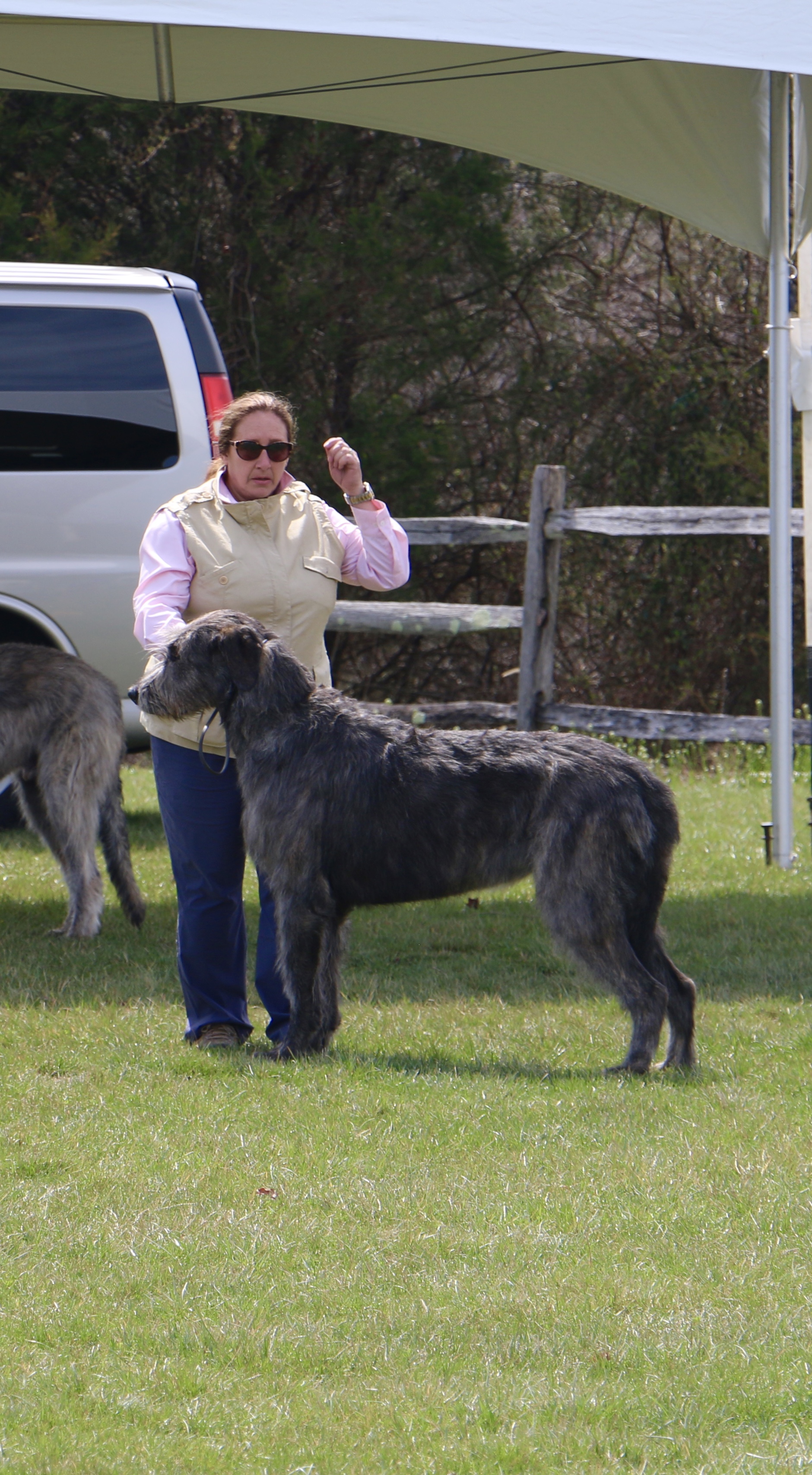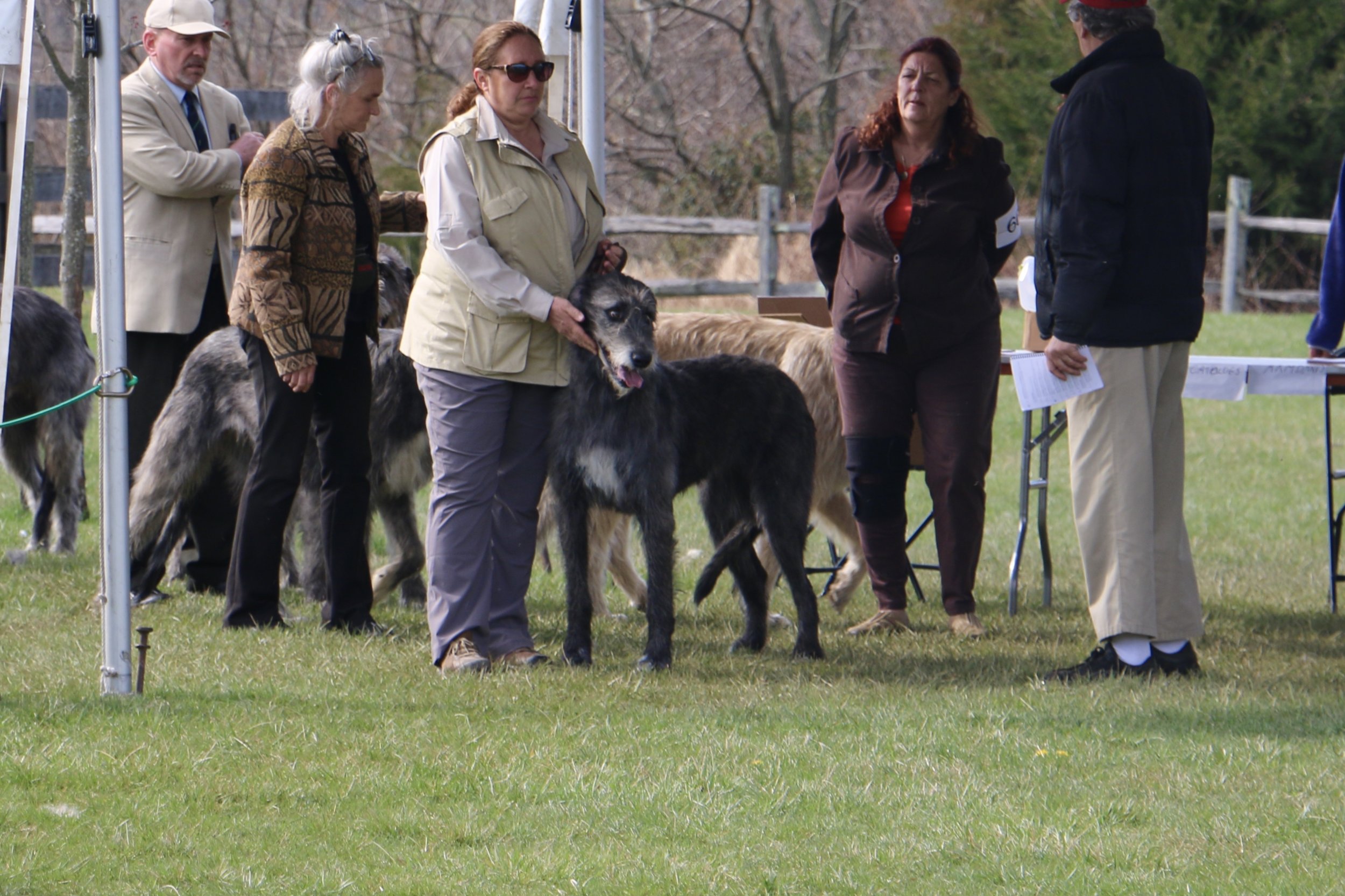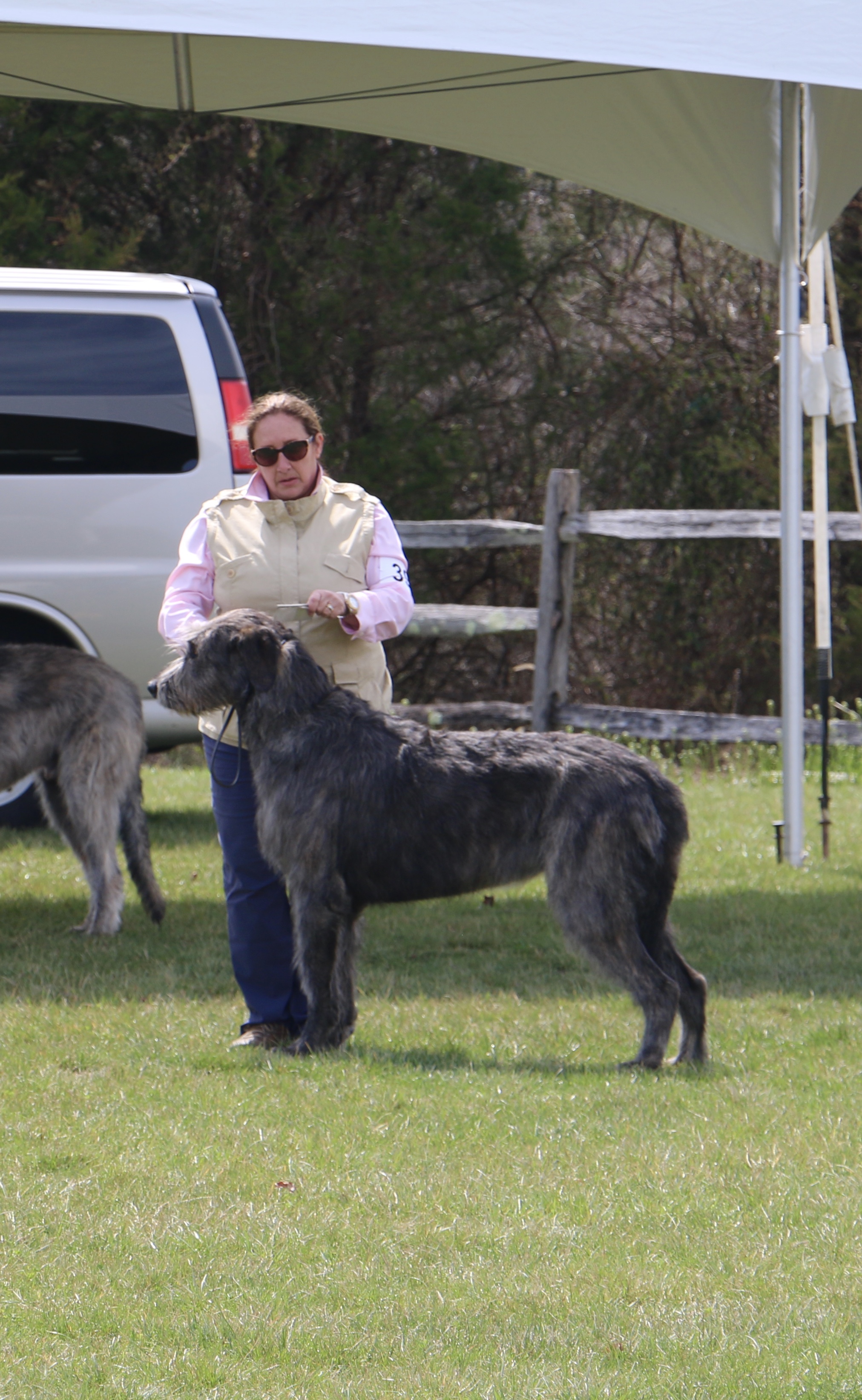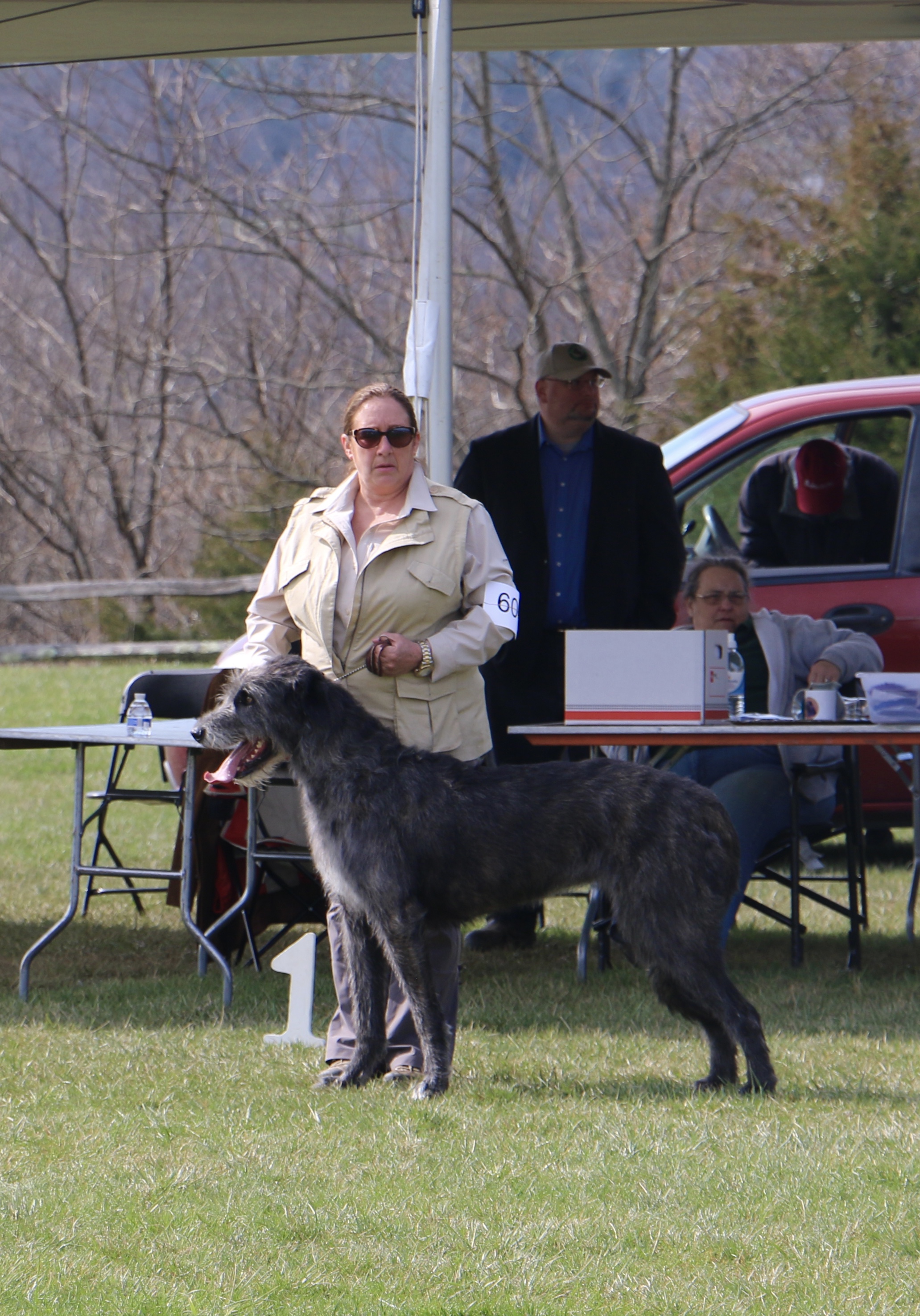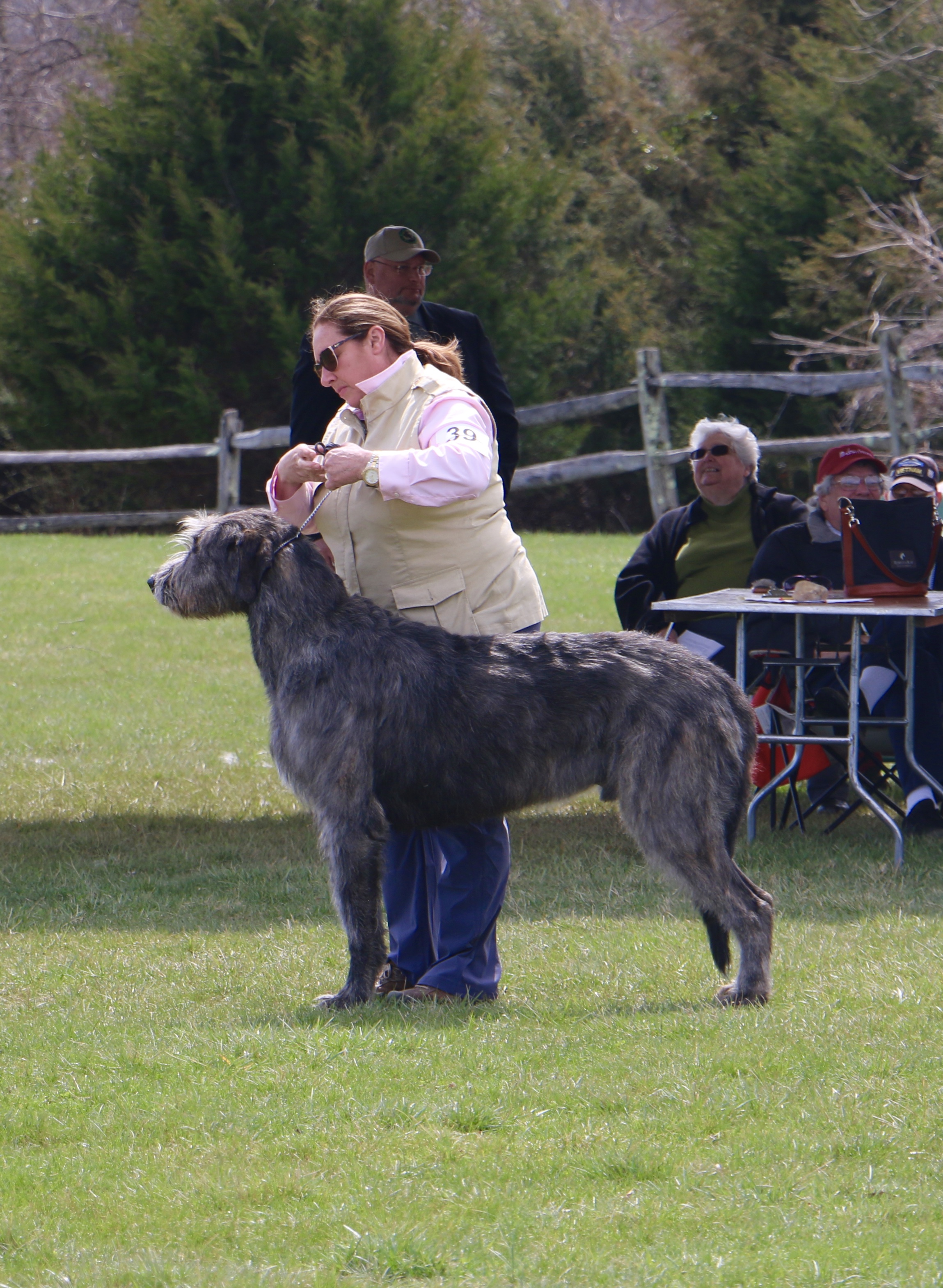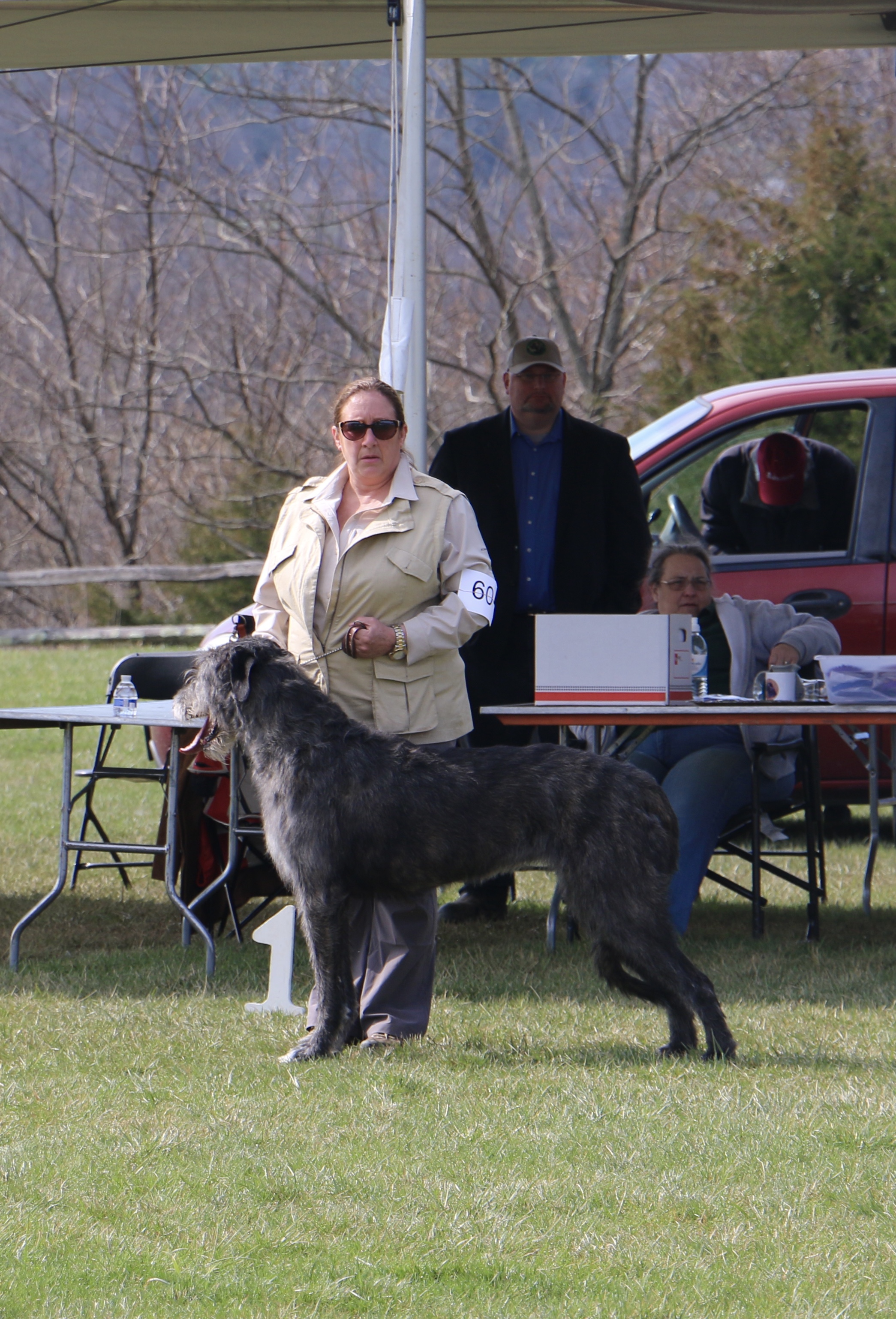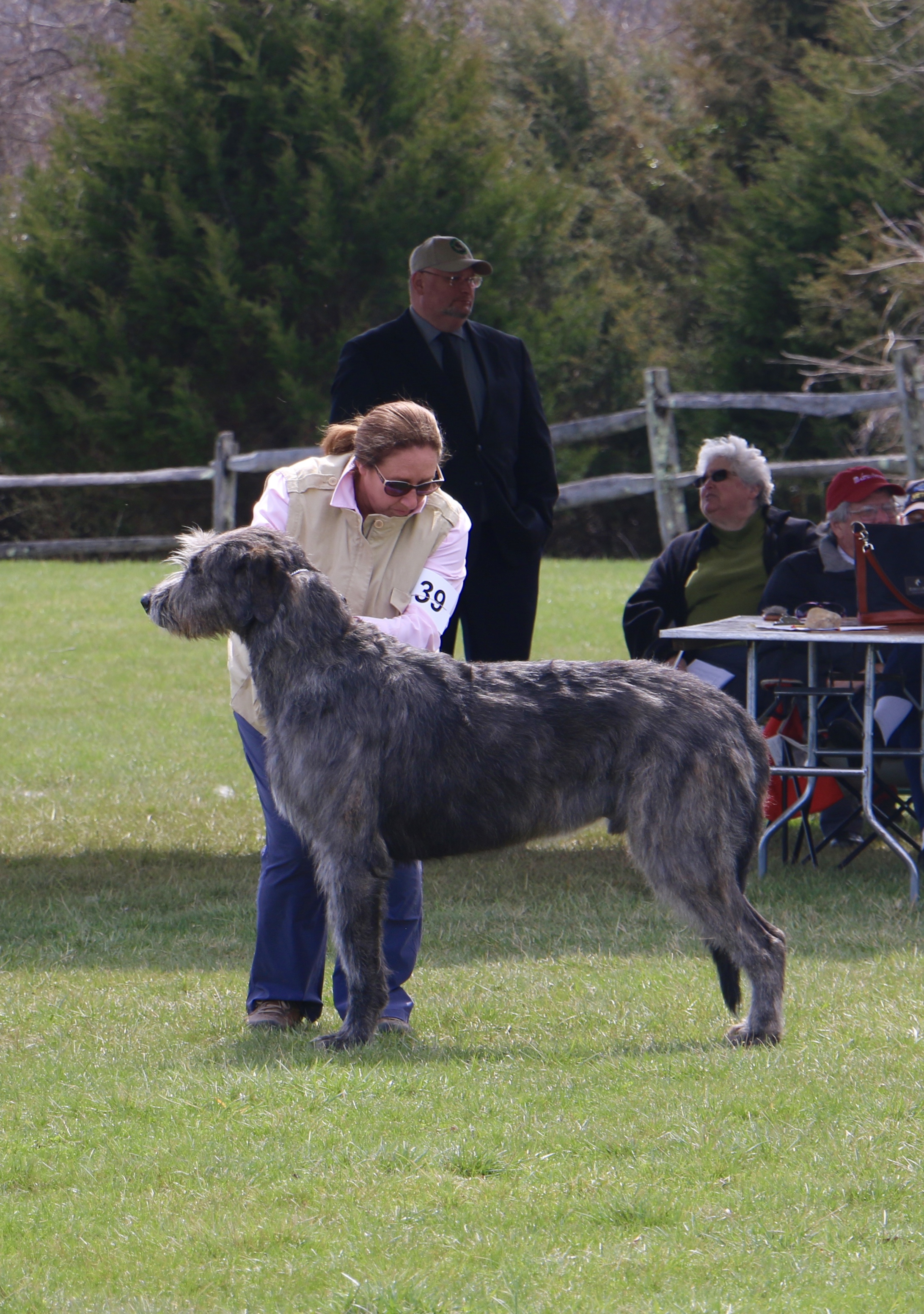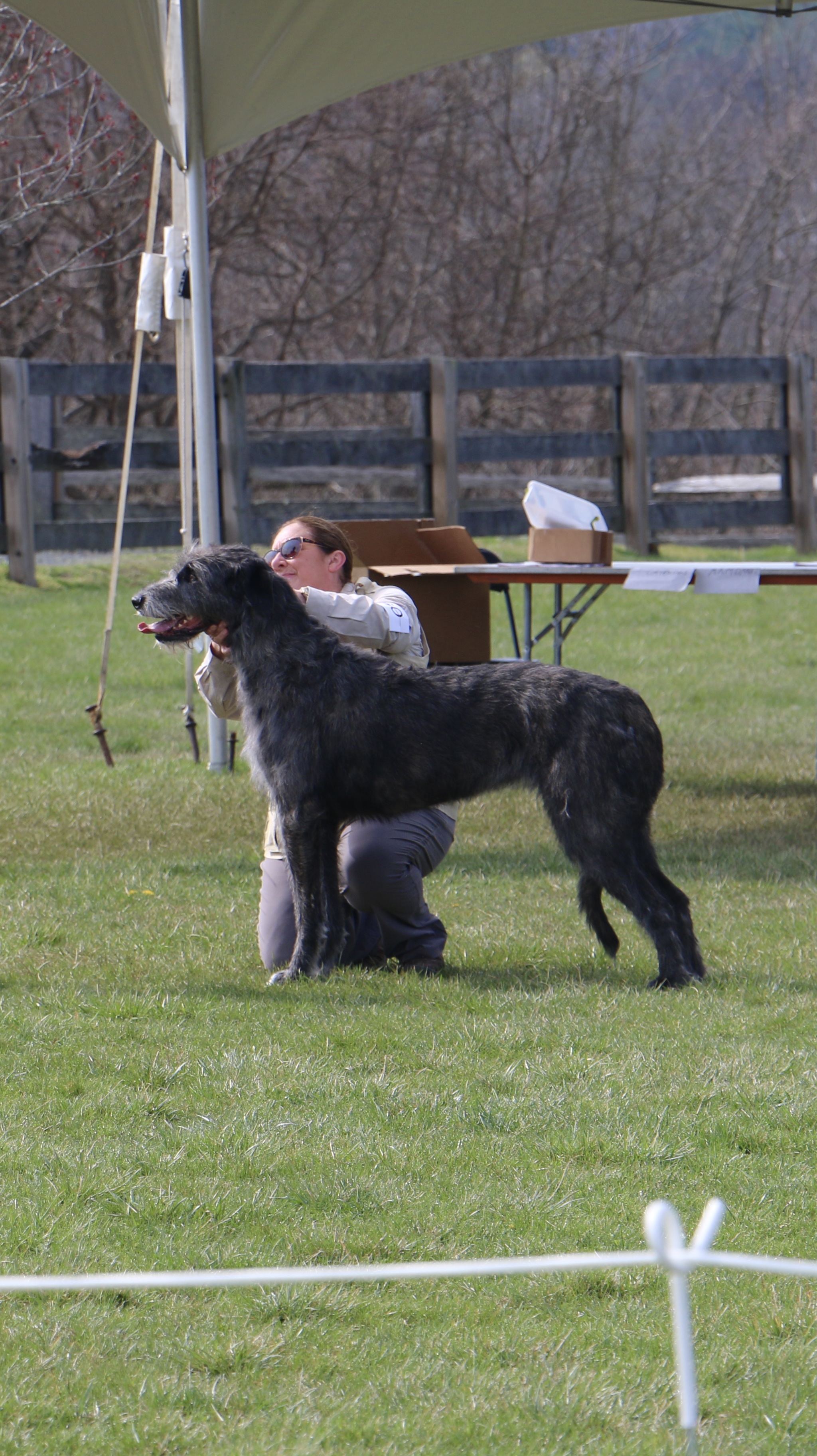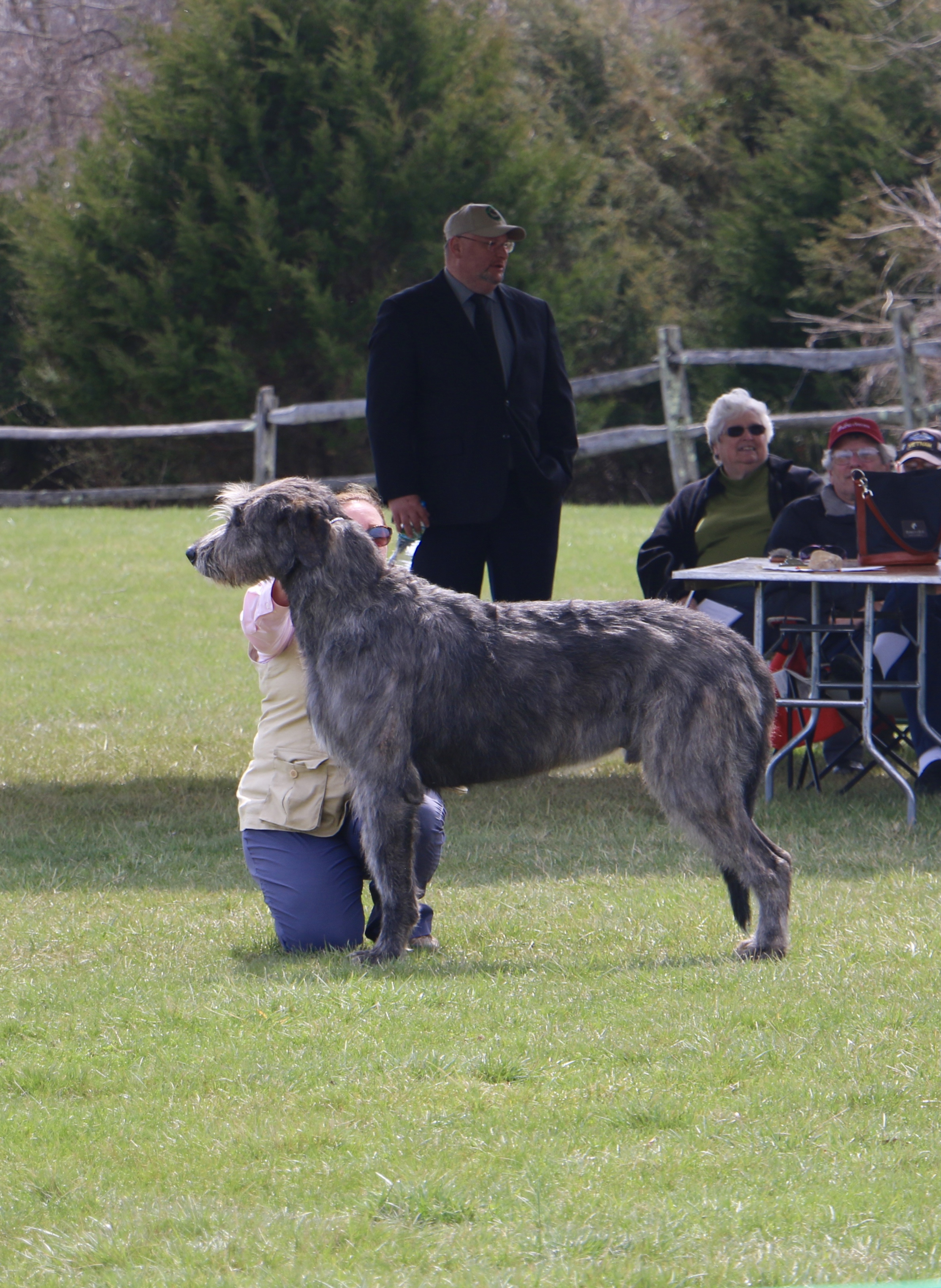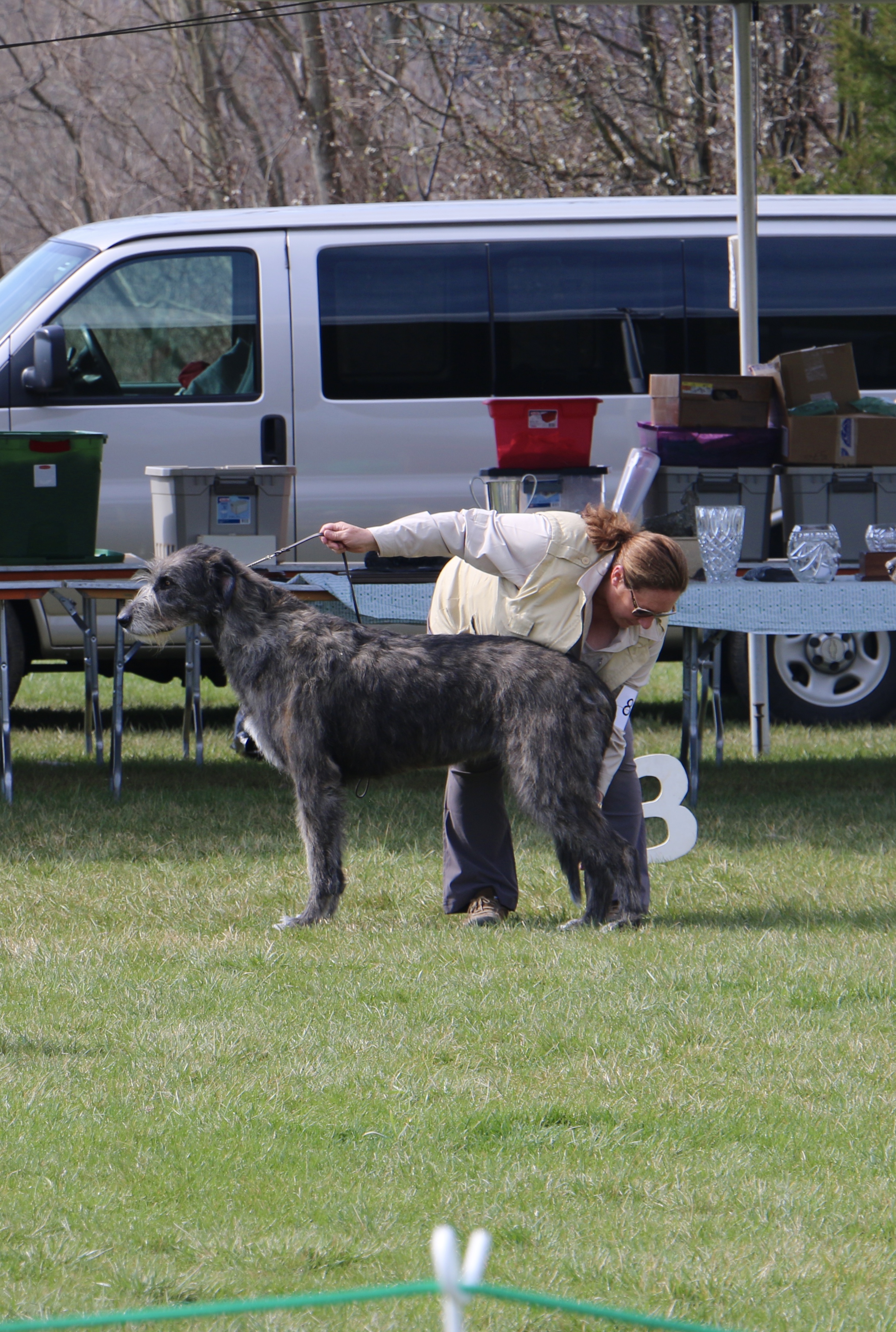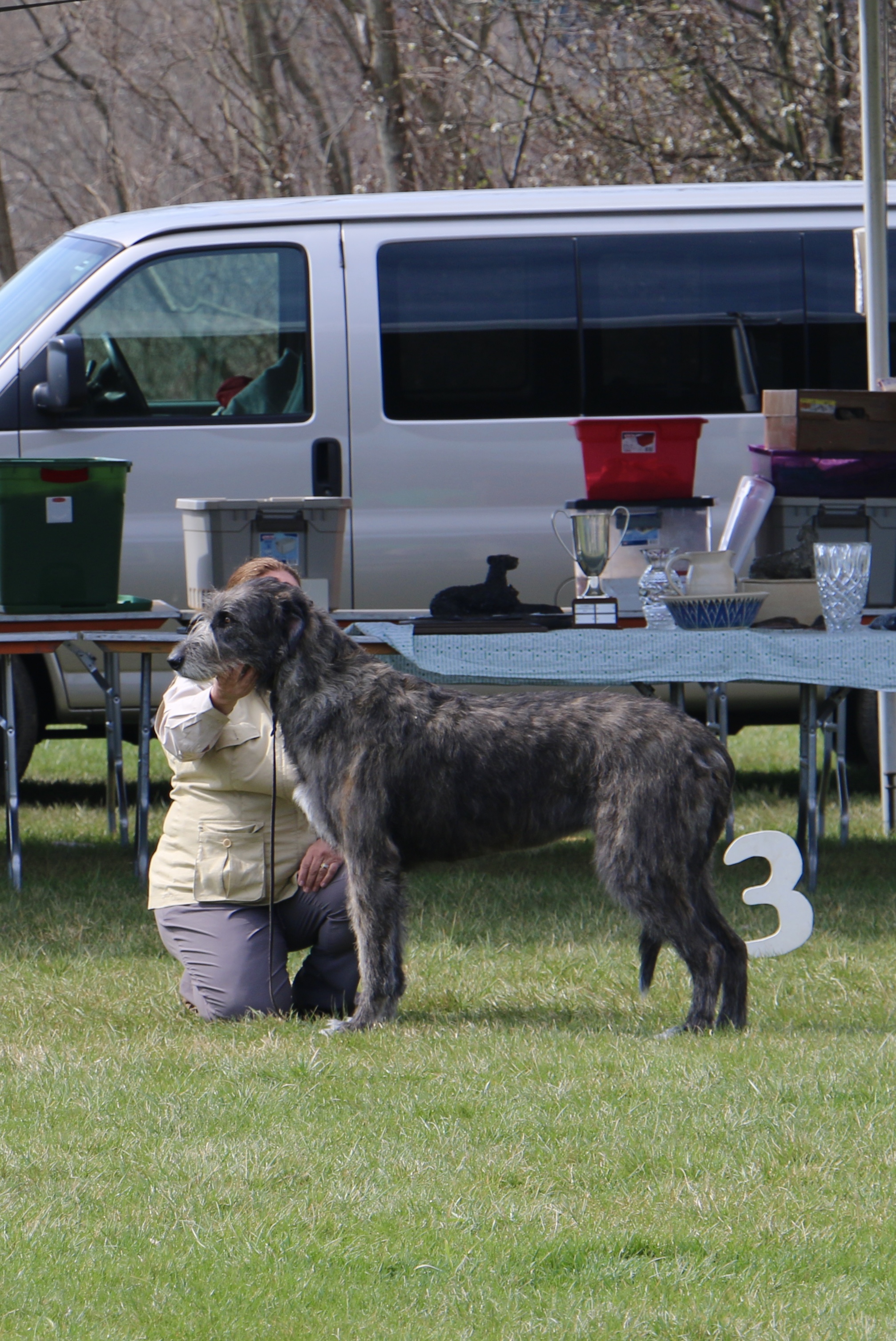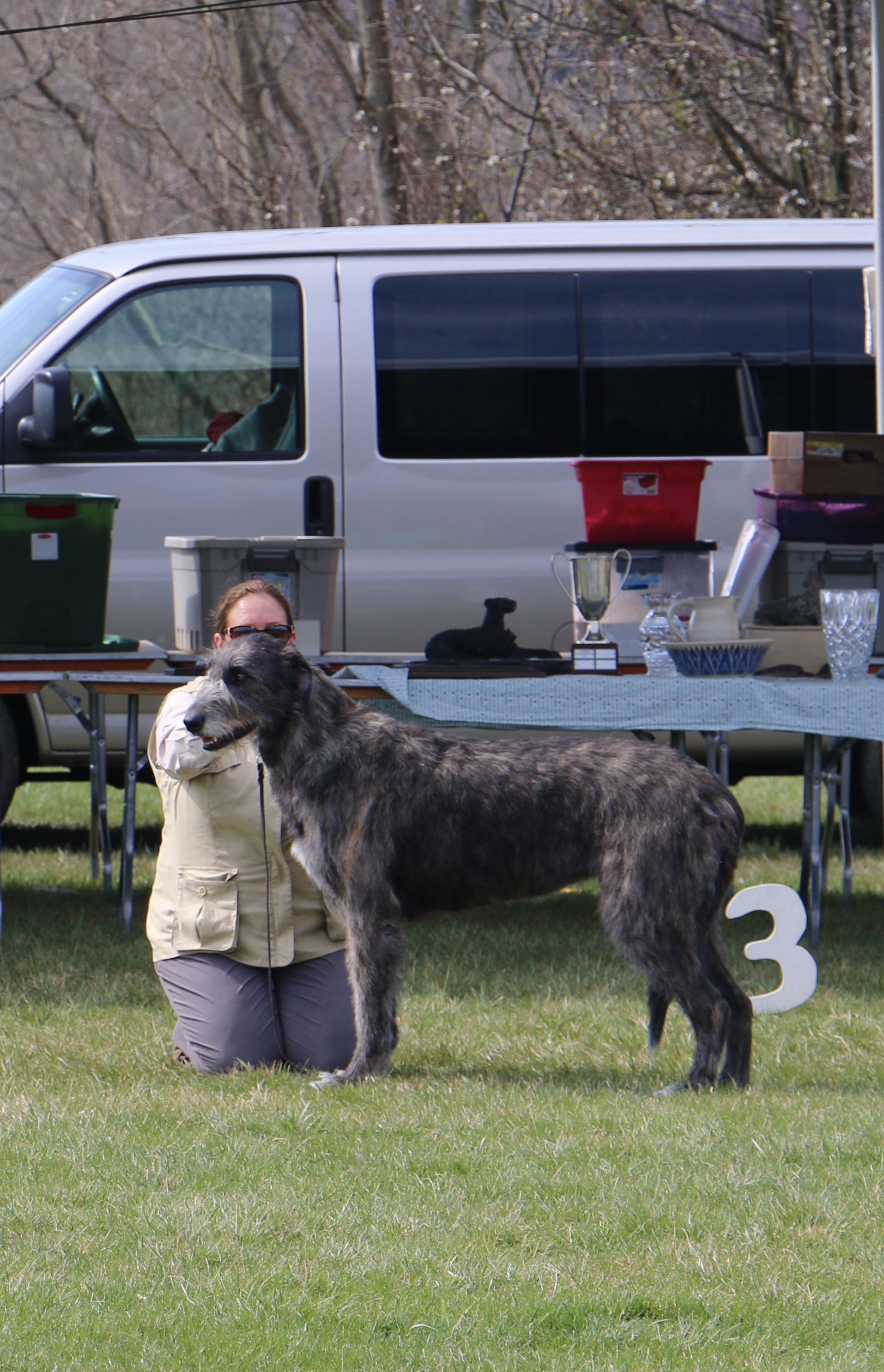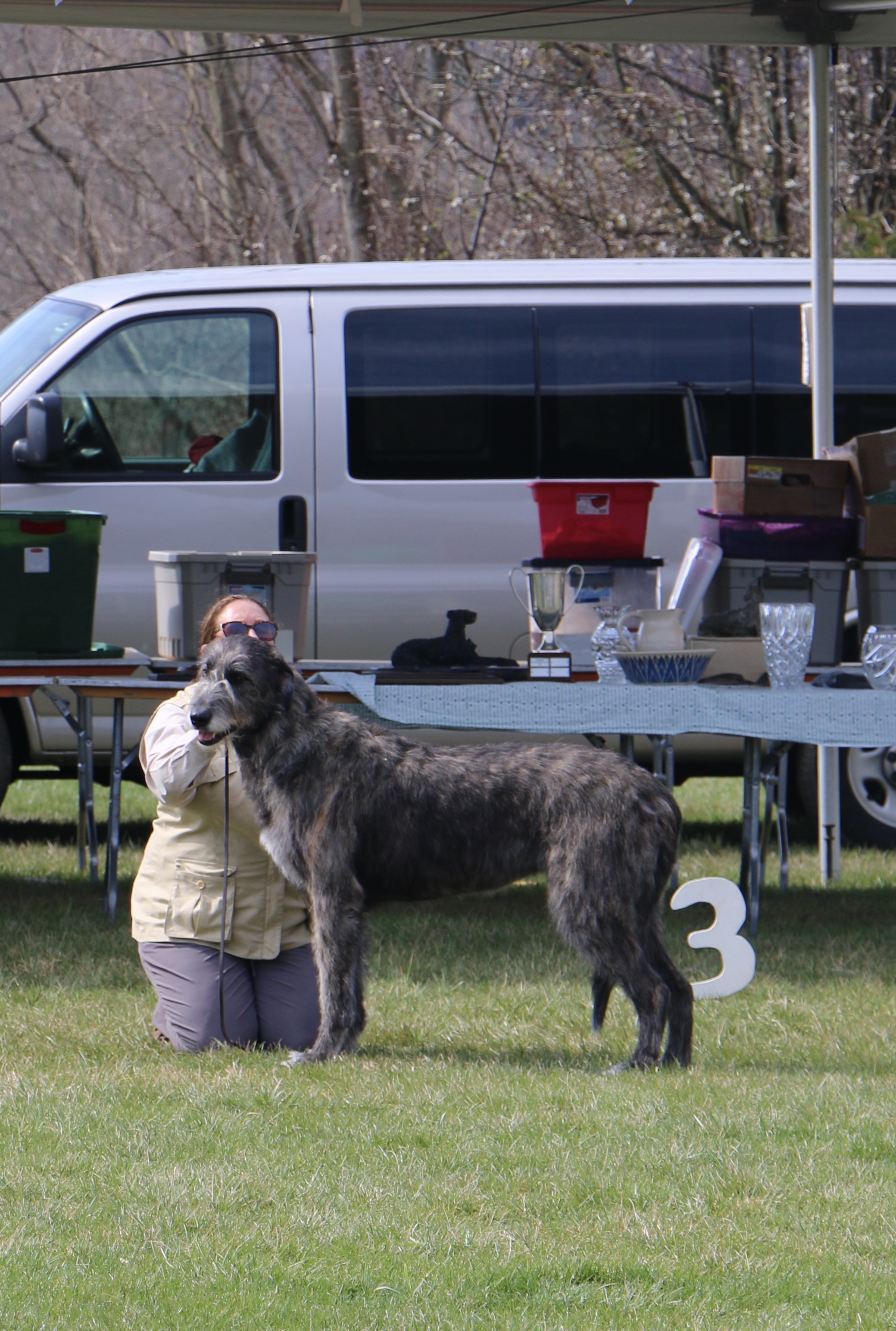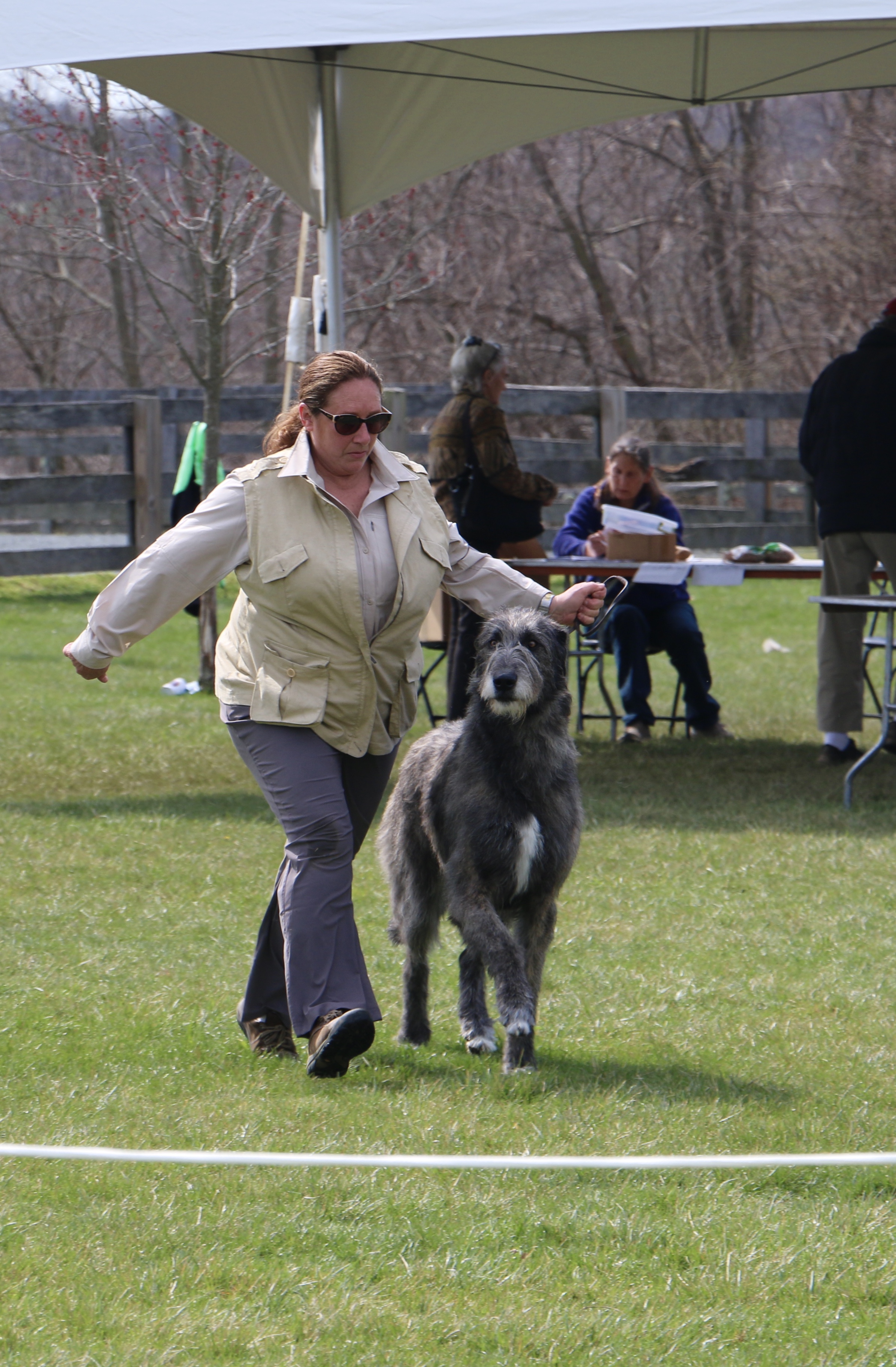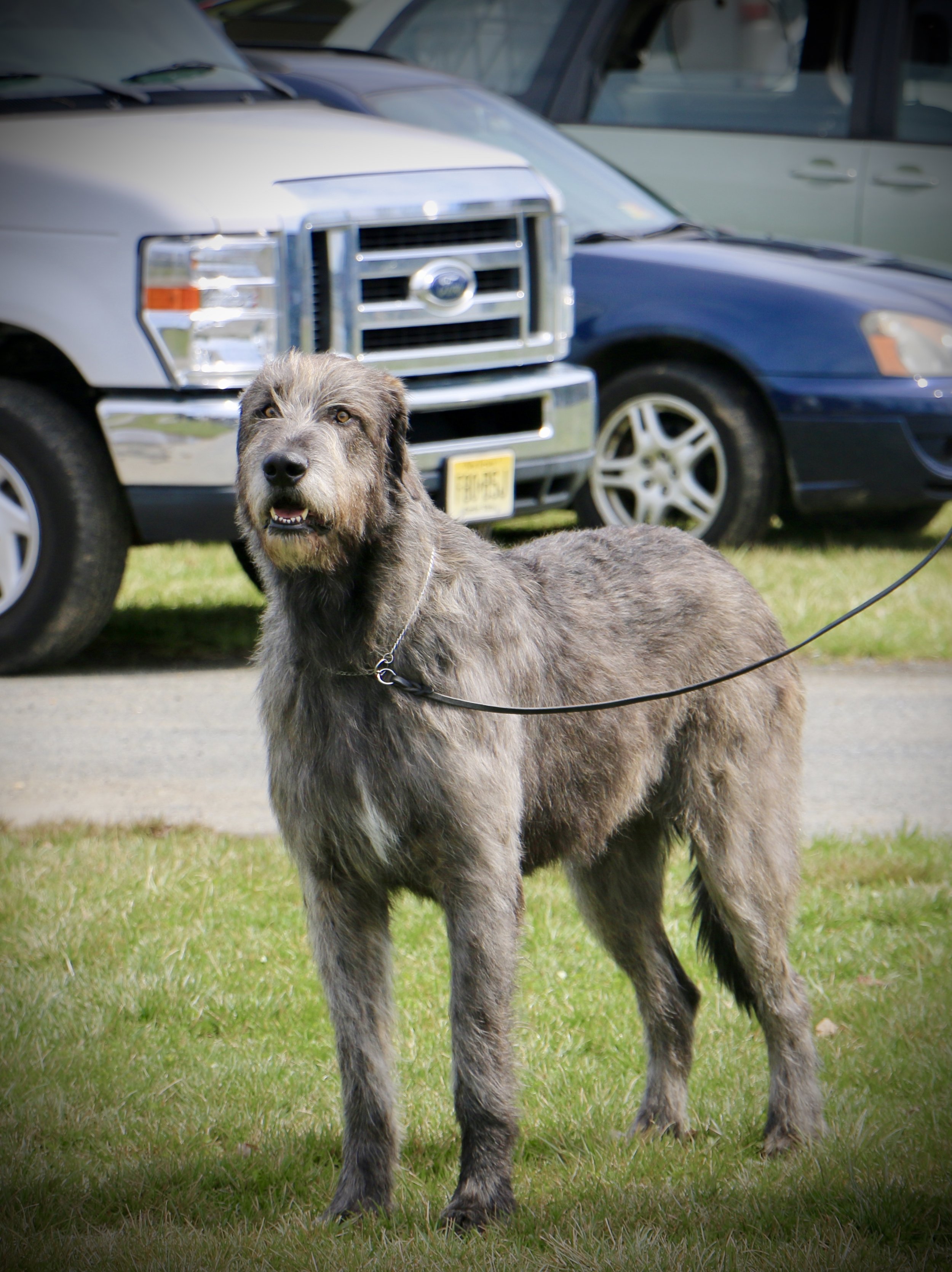For those dog owners managing a hound with ventricular premature contractions and possibly supraventricular arrhythmia's who have not had ideal results from the typical drugs of choice and/or whose hounds have suffered side effects from such drugs, then here is a new idea............
Ballyhara Ki & Kellyanne most recent candids
Ballyhara Kellyanne 3 years
Ballyhara Ki 3 years
Ki doesn't relax when he is set-up in a show stance....his sister Kellyanne cares less! I normally do not post formal show photos but I have not been able to get any photos of Kellyanne and very few, if any of Kate because my husband has had to gait the hounds at the shows due to a knee injury I received several months past. As a result, I have presented the hounds and my husband co-breeder and co-owner has gaited them leaving us with no one to photograph the hounds. However, ironically it turns out that my husband gaits the hounds better than I as I cannot keep us with this litter! These wins are at the Hudson River Valley Hound Show in Carmel, New York with Dr. Andrea Bradford adjudicating.
Candid Photographs
Some candid photos from recent Specialties on just a few Ballyhara Hounds.
Several of these photographs at the end were taken by Lauren Swick. Our appreciation to Laura for sharing these as I had a knee injury and my husband Bobby had to gait the hounds so we could not take photos ourselves.
Another Important Note on Blastomycosis
Last week I forgot to include that the areas in which Blasto is frequently diagnosed includes Upstate New York! In fact, the Merck Manual Consumer Version states that:
"Most cases of blastomycosis occur in areas of North America where the fungus lives in the soil near river beds:
The Ohio and Mississippi River valleys (extending into the middle Atlantic and southeastern states)
The northern Midwest
Upstate New York
Areas of southern Canada that border the Great Lakes and Saint Lawrence River
Moreover, I wanted to especially highlight a remedy included in my last post from Dr. Becker at Mercola about Blasto as it may have been overlooked by some. That being Oil of Oregano which is an excellent support for a body fighting a fungal infection. More on the benefits of such can be found here.
In fact, my family uses Oil of Oregano at the first sign of a cold, as well as I have used it if my pollen allergies start acting up. This remedy is remarkable and we swear by it. Taken in its purest form via a dropper in a glass of water at the first sign of a sniffle or cold coming on, we repeat it up to four times daily for a day or two. Be forewarned, it is absolutely awful tasting, and you must hold your breath while downing the water but it works magic for us. You think I am exaggerating but I am not -- its awful tasting -- however, I sure as heck prefer taking Oil of Oregano than cold medicine to lessen the severity of constant sneezing, coughing, stuffed-up nose, sore throat and on and on...
Blastomycosis
Blasto, the short term for this fungal disease has very serious repercussions not just for dogs but for humans as well. This disease has been dreaded by many, many dog breeders and farmers in the endemic areas of the country as depicted in the Center for Disease Control (CDC) map below. First, what is it? The CDC reports........
2017 Irish Wolfhound Quebec Regional Specialty & Underage Puppies
Nostaglia for the Good Old Days
We often hear people say how different life or events were in yesteryear. Often we reflect on things or people that we miss, our nostalgic memories vivid as if it were just yesterday. I frequently find myself doing so as I reminisce about how our breed society once was and the stark contrast to what it is today. The consequences of such disparities are substantial being that today we now have the lowest standards of acceptability and accountability within our organization and society. The 2017 IWCA National Specialty recently provided several instances that aroused my sentimentalism........
Update on Canine Influenza from May 27 Post
This notice is being sent out to provide up-to-date and accurate information about the Canine Influenza Virus to help prevent the spread of the virus to healthy (unexposed) dogs. The information provided is not intended to alarm dog owners and handlers.
There are recently confirmed cases of the Canine Influenza Virus (H3N2 strain) that was first brought to and identified in Chicago, Illinois in the spring of 2015. The most recent outbreaks concern the following states: Florida, Georgia, and North Carolina.
Canine Influenza Virus is an extremely contagious airborne disease that is easily spread among dogs, and in rare instances, can be contagious to cats. If you believe one of your dogs may have contracted the Canine Influenza Virus, immediately isolate it from other animals and contact your veterinarian.
Here is some additional information about Canine Influenza Virus and tips for how to minimize the risk and reduce the spread of the disease:
Canine Influenza Virus
- Canine Influenza Virus is spread through:
- Close proximity to infected dogs (it is airborne and can travel up to 20 ft.)
- Contact with contaminated items (bowls, leashes, crates, tables, clothing, dog runs, etc.)
- People moving between infected and uninfected dogs
- 80% of all dogs that are exposed to the virus will contract it
- The virus lives up to 24 hours on soft surfaces and up to 48 hours on hard surfaces.
- Some exposed dogs will be subclinical carriers - meaning some dogs will contract and spread the virus without showing symptoms.
- Dogs show clinical signs within 24-48 hours and can shed the virus for up to 28 days from exposure.
- Most dogs will completely recover with proper treatment.
- Dogs that regularly interact with dogs outside of their own family or frequent places where many dogs gather are most susceptible to exposure to Canine Influenza Virus.
Symptoms
- Dry, hacking cough (similar to kennel cough)
- Lack of appetite
- Lethargy
- Discharge from the nose or eyes
- Fever (normal temperature is 101 – 102)
Prevention
- The best protection is vaccination. There is now a single vaccination for both the H3N2 and H3N8 strains of the virus. The vaccination requires a booster shot two weeks after the initial vaccine. Vaccination provides the best chance of immunity within 7-14 days of booster shot.
- Isolate sick animals and keep them isolated for up to 30 days after symptoms subside.
- Practice good sanitation. Use a bleach and water mixture diluted to 1-part bleach x 30 parts water to disinfect common areas such as tables, bowls, leashes, crates, etc. Allow items to thoroughly air dry for a minimum of 10 minutes before exposing dogs to them. Bleach breaks down quickly so solution should be made daily. Keep in mind that bleach becomes inactive in UV light. If mopping use two buckets so as not to cross contaminate areas
- Wash your hands frequently, ideally between handling different dogs. At the very minimum, hand sanitizer should be used between handling dogs.
- Use disposable gowns or wipe down clothing and shoes with a bleach solution between dogs or after leaving an area where dogs congregate.
- Food/water bowls should be made of stainless steel instead of plastic because scratched plastic is hard to fully disinfect.
Treatment
- Treatment of Canine Influenza Virus requires veterinary assistance. If you believe your dog may have Canine Influenza Virus, please contact your veterinarian immediately. Untreated, the illness may progress to pneumonia or other, more serious problems. H3N2 can lead to severe secondary pneumonia which can cause extremely sick dogs with potential fatalities.
- Most dogs take 2-3 weeks to recover from the illness.
Containment
- Any dog suspected of having Canine Influenza Virus should be immediately isolated from other dogs and should not attend dog shows, day care, grooming facilities, dog parks, or other places dogs gather. Dogs are contagious for up to 30 days once they have started showing symptoms.
- Contact your veterinarian to let them know that your dog may be showing symptoms of Canine Influenza Virus. If your dog is going to a veterinary hospital or clinic, call ahead to let them know you have a suspected case of Canine Influenza Virus. They may ask you to follow a specific protocol before entering the clinic to minimize the spread of the disease, including waiting in your car until they are ready to examine your dog.
- Keep sick dogs at home and isolated from other dogs and cats until you are certain the illness has run its course (typically 3-4 weeks).
Consideration for Event Venues
- Use a bleach and water mixture diluted to 1-part bleach x 30 parts water to disinfect common areas including show floors, grooming tables, ring gates, in-ring examination tables and ramps, and x-pens. Allow solution to completely dry (at least ten minutes in order to assure virus has been killed). Bleach breaks down quickly so solution should be made daily. Keep in mind that bleach becomes inactive in UV light. If mopping use two buckets so as not to cross contaminate areas.
- When wiping down hard surfaces paper towels are preferred over cloth.
- Consider having two exam tables at every ring so that they can be cleaned and allowed to air dry frequently in between classes.
- Provide hand sanitizer in each ring and in grooming areas.
- Exhibitors should consider grooming dogs at their cars instead of using grooming areas where dogs are in very close proximity.
Dr. Jerry Klein is a veterinarian in the emergency room at Chicago’s largest veterinary emergency and specialty center. He was personally involved in treating hundreds of dogs sickened by the H3N2 virus during its initial outbreak in Chicago in spring of 2015. He is also an AKC licensed judge.
Are There Foreign Imported Dogs at Your Local Animal Shelter?
I want to share with you an interesting article that just came through the "AKC Communicates." Written by Patti Strand, President NAIA titled "Animal Rights Legislators Push Window Dressing Laws Instead Of Tackling Real Dangers" the article discusses the absence of regulations on animal shelters, rescues organizations and weak US pet import laws but importantly, the dangers associated with these ineffective laws. We should all be mindful of this problem not just for our public health but also for our dog's well-being.
Conformation Judges Oral Examinations
AKC strongly advises that all judges should ask the exhibitor to show the bite/open the mouth when conducting oral exams.
It is a shame that our international wolfhound judges having an extreme obsession with dentition are not versed in or with AKC's The Rules, Policies, and Guidelines for Conformation Dog Show Judges. The handbook states, "Study of the approved breed standard will define the proper oral exam for that breed." Note that the current IWCA Breed standard does not denote bite......
AKC Canine Influenza Warning!
Many of us have just returned from the Irish Wolfhound Club of America National Specialty and should be aware of this recent warning from AKC on May 25, 2017, about a Canine Influenza outbreak in Georgia and Florida. Keep in mind that there were exhibits in attendance from these areas and though I am not aware of any hounds that were ill; remember that dogs may shed the virus without displaying symptoms. So, be alert if you have returned from the National Specialty.
“We have received notice of confirmed cases of canine influenza in dogs that were at events in Georgia and Florida over the past 7-14 days. Please monitor your dogs closely. As you know, the virus has an incubation period of 2-5 days and dogs may be shedding the virus while showing no signs. Dogs with fevers, poor appetites, coughing, sneezing, runny eyes/noses should NOT be exposed to other dogs or people. If your dog is ill or exhibiting symptoms, the best option is to seek veterinary attention and refrain from bringing the dog out in public until they are medically cleared by your veterinarian. ”
For more detailed information on canine influenza, please view this article.
Grass and Our Dogs Fascination With it!
This topic "Why Do Dogs Eat Grass?" was just highlighted by Dr. Jean Dodds in her Hemopet Newsletter, and essentially, gives substance to my long-held belief: that eating grass is a powerful, ancient urge which is very much alive in our carnivores today.......
POW -- A New, Very Frightening Tick Disease
POW -- This is the acronym for the Powassan Virus that is transmitted by ticks which are mostly carried by deer. Do not be mistaken -- POW is very, very dangerous. Recently, I heard about this once believed rare virus on a news report and that the spread of the virus, by tick bites, is increasing. Worse, transmission is within the first 15 minutes of contact......
Ballyhara Candid photos from recent Potomac Specialty Show
Here are a few candid photos of my Irish Wolfhounds from a recent specialty show.
Dogs in Review Point/Counterpoint
A recent conversation in Dogs in Review Point/Counterpoint topic of the month section that I thought was engaging as the guest panelists answered in a thoughtful, meaningful manner. The subject matter is not new:
"In your experience, is the average exhibitor today more knowledgeable or less knowledgeable about breed standards, canine structure, and gait than he/she was 10 years ago?"
I know that this problem has been debated for at least 15 plus years alone in my circles, despite the ten years the point/counterpoint mentions......
Terrific Meat Grinder for Preparing Fresh Dog Food
Holter ECG Ambulatory Monitor
My last Blog article, Irish Wolfhound Heart Health, stressed the importance of the portable, ambulatory ECG device called a Holter Monitor. A portable 24-hour ECG that is an essential tool for diagnosing, screening, and eventually managing canine myocardial dysfunction, tachyarrhythmias, and congestive heart failure. Here is what they look like and how they are worn.....
Irish Wolfhound Heart Health
In the Irish Wolfhound breed, regular annual heart evaluations or workups consisting of electrocardiography (ECG or EKG), echocardiograms, and an ambulatory heart monitor (ECG), e.g., Holter Monitor are essential and indispensable...Why use a Holter monitor if an ECG and Echocardiogram detect no ventricular arrhythmias (abnormal heart rhythms)?....
Poop Scooper Rating on Lee's Stool Tool Clean up System
Now and then I like to provide helpful and honest feedback on products that dog fanciers frequently purchase. One of the common items that multi-dog owners buy are poop scoopers. Boy, do we have experience with these. You might think that they are all alike. However, you would be wrong in that assumption. Yes, there are various styles, but I am not discussing rake or claw style -- I am talking about the spade and pan style which is a must-have for giant breeds. As for the rake style, I always wonder why people buy these because they are not helpful when your dog has diarrhea. Anyway, moving on....
I had previously posted quick feedback on another brand of poop scooper spade and pan style which you can read here. This time around we purchased three of Lee's Stool Tool Cleanup System, Large Tray w/Scraper/Spade from Amazon. What the heck, I tried all the other brands and had not been satisfied because they break too soon. Yes, even the metal ones. We go through a set of three Poop scoopers throughout our property in 6 months to a year. Usually, the rivets pop off the back of the pan which is how it is attached to the hollow metal handle. Then you are left with a pan having no handle. We live in the mountains and experience sub-zero winters with lots of ice which poses a problem when you are cleaning dog waste from the yards and paddocks. Most times you are chopping away with the side of the spade to loosen frozen dog waste despite our diligent and constant four times a day cleanup schedule.
Lee's stool cleanup tray and spade are made of plastic. The description of the material is "Rigid PVC (High Impact Styrene), " but I was under the mistaken impression that it would be a much sturdier product. On the whole, they are mostly worthless to use if you have hard snow or icy conditions. This product would, however, be ideal for warm climates having no snow, and the plus side is that the PVC is slippery so dog waste does not stick as it does on metal pans leaving residue behind! The downside to the slipperiness is that you best keep the pan level at all times or the waste will slide right off, and you will have to start all over again. All in all, no, we would not buy this brand again as it was a waste of money for me if I cannot use it year-round. Additionally, the plastic is too flimsy.
Dog Foot Pad Injuries
What a pain in the arse an injury to a dog's foot pad can be! It is a difficult location to heal quickly and can take what seems to be forever. Usually, a textbook healing process in this area, in my considered experience, is rare. If your dog has a foot injury, then this advice and helpful tips may aid the tedious and very worrisome process of healing a split or cut pad, an infection or abscess or even hot spots between the toes......






